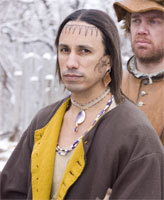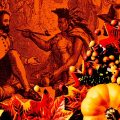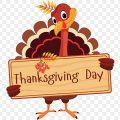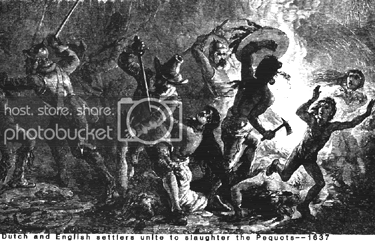What follows is a heavily edited version of my last year’s Diary on Thanksgiving.
 I forced myself to watch the History Channel’s Desperate Crossing: The Untold Story of the Mayflower last weekend. I don’t feel as if I totally wasted my time. Including performances and interviews of some Wampanoags, descendants of the indigenes who saw the Puritans make landfall 387 years ago, made the program a good deal more palatable than it might have been.
I forced myself to watch the History Channel’s Desperate Crossing: The Untold Story of the Mayflower last weekend. I don’t feel as if I totally wasted my time. Including performances and interviews of some Wampanoags, descendants of the indigenes who saw the Puritans make landfall 387 years ago, made the program a good deal more palatable than it might have been.
I would have preferred a bit more about how one reason the Pilgrims were “persecuted” in England and Holland was because of their efforts to get everyone to comply with their own crabbed view of religion. Something they also did here in America. Not dissimilar from what some modern day others would like to do now. But what an improvement the program was over past efforts.
For the past few years, my wife – who supervises the largest English as a Second Language program in the United States – and I have had numerous conversations with Los Angelenos of various ethnic and religious backgrounds about the turkey they’ll be eating three days from now. Doesn’t matter if they’re originally from Senegal or Guatemala, Belarus or Vietnam, Scotland or China, it’s the same story with all of them: turkey has to be on the table.
Not that it’ll be a traditional turkey dinner with cranberry sauce and yams and stuffing. Trimmings can range from Libyan tajeen to a cold Vietnamese egg soup whose name I’ve forgotten. And everybody’s bird seems to be done just a little differently. Two years ago, I got to taste Thai turkey, which is definitely not for mild palates.
I don’t buy the “melting pot” theory of American history, nor am I a sappy kind of guy. On the other hand, since I had my Thanksgiving “conversion,” I’ve found something distinctly appealing, yes, even uplifting, about this widespread integration of cultures through the medium of food and family get-together.
I love conversation, I love food and I love celebrations. This year, as last, we’ll be celebrating with friends at the Santa Clara Pueblo home of a college friend. A few years ago, I wouldn’t’ve done this.
Because, when I was a child, we never celebrated Thanksgiving. My grandfather forbade it. A white man’s holiday based on white men’s lies, he said. His take on the holiday was no distortion. But his opposition to commemoration was doubly disappointing for me. I was born on Thanksgiving. Actually, November 28. But, that year, 1946, Thanksgiving fell on the 28th, and ever since, it’s been my designated birthday, whatever the actual date.
While other kids, including other kids with Indian roots, celebrated Thanksgiving with all kinds of food, our house might as well have been shrouded in crepe. Based on what made it to our table, I think he may even have told my grandmother to cook less than usual. Nobody grumbled. My grandfather was an honest, principled man, but quick-tempered, and although he rejected almost every other teaching in the Bible, he believed fully in the bit that sparing the rod would spoil the child. We were not spoiled.
We left the South and my grandfather when I was 10. I had half a dozen guests at my first-ever birthday party – on Thanksgiving Day – when I was 12. I was ecstatic. Thereafter, until my senior year in high school, I celebrated Thanksgiving and my birthday with a party. Cake and turkey. It was then, 44 years ago, that I began reading in earnest about America’s historical treatment of indigenous people, including my ancestors.
That year, November 28 again fell on Thanksgiving. But I didn’t celebrate. No party. And that’s the way it was for the next 29 years, during which I reiterated my grandfather’s warning. He had not been mistaken about the holiday being founded on the fruits of mass murder instead of some friendly, integrated get-together.
The Wampanoags who arrived on what many of us were taught in school was the “first” Thanksgiving, were not invited to the feast with the Plymouth Pilgrims in 1621 after having rescuing them from certain starvation. Massasoit and about 90 of his men just showed up. What followed was three days of eating and entertainment, much of which included large quantities of beer. The tension was surely palpable. In the sole firsthand, contemporaneous account we have, nobody called it “thanksgiving.” Not long afterward, in an act of raw treachery that was precursor to a thousand others over the years, Captain Myles Standish, military commander of Plymouth colony – determined to make a pre-emptive strike against a non-existent military threat – strode into a Wampanoag village with his men on the pretext of trading. He left with the severed head of Wituwamat, which he stuck on a wooden spike at Plymouth.
The real first Thanksgiving was declared in 1637 by Massachusetts Bay Colony Governor John Winthrop, he of the famous “city upon a hill” speech. That celebration capped off the Mystic, Connecticut, massacre of 400-700 Pequots, southern neighbors of the Wampanoags, remnants of a tribe already deeply wounded by epidemics of smallpox and measles. Survivors were executed or sold into slavery in the West Indies. Proclaimed Winthrop, “This day forth shall be a day of celebration and thanksgiving for subduing the Pequots.”
The descendants of Massasoit’s Wampanoags who had sat down in 1621 were treated to their own slaughter during King Philip’s War 54 years later. After decades of being pushed off their old lands, the Wampanoag were led in resistance by “King Philip,” known among his own people as Metacom. When the year of fighting was over, his wife and son were captured and sold into slavery in Bermuda. Metacom was decapitated and his head publicly displayed for more than 20 years. Once again, survivors were executed or sold into slavery, with a bounty of 20 shillings offered for every Indian scalp and 40 shillings for any captive able-bodied enough for enslavement.
On June 20, 1676, the governing council of Charlestown, Massachusetts, proclaimed:
“…It certainly bespeaks our positive Thankfulness, when our Enemies are in any measure disappointed or destroyed; and fearing the Lord should take notice under so many Intimations of his returning mercy, we should be found an Insensible people, as not standing before Him with Thanksgiving, as well as lading him with our Complaints in the time of pressing Afflictions:
The Council has thought meet to appoint and set apart the 29th day of this instant June, as a day of Solemn Thanksgiving and praise to God for such his Goodness and Favour…”
That slaughter of “heathens” and the round-up of survivors which followed allowed more European immigrants to squat on what had once been Indian land. It was a theme that kept being repeated for the next 220 years right across America. My own people – Seminoles, an amalgam of Creeks, Apalachees, runaway slaves and “renegade” whites – eventually fought three wars, and kept a few slivers of their traditional lands, although most were force-marched to “Indian Territory,” where their descendants still live today.
Every year, I ranted about these brutal injustices, about the hypocrisy of Thanksgiving, and the fate of the people who suddenly were in the way. And then, 13 years ago, I let it go. Not that I changed my mind about the atrocities that had occurred or the lies that had been told about them. Not that I become enamored with the foolish iconography of Thanksgiving, including elementary school displays of construction paper Pilgrim hats and feathered headbands. Not that I did not and do not fully understand the feelings of those who cannot bring themselves past their rage at this celebration which has been given a full platter of historical up-is-downism.
But I got tired of missing out on the celebration and the food … and I missed having a birthday party. And I realized, finally, that I also had missed the point that this holiday can be a healer, a remembrance of our roots but with our eyes on the present and the future. So, this year, as in the past few, I’ll be together with some of my best friends, white, red and black. As we have for several Thanksgivings, we’ll tell the children (and grandchildren) the true story of Thanksgiving.
And we’ll give thanks that we live in a country where remembering the past need not shackle us to it.



We skins have always celebrated at this time of year so a good feast shouldn’t be passed up! btw, Back in the day I was in the 3rd Recon, 2nd Amrd Cav,(formally Dragoons) who gained fame chasing Seminoles all over Florida. And for some reason I always mention that to my ‘nole friends around thanksgiving… I have no idea why:). Have a good one, CC
We skins have always celebrated at this time of year so a good feast shouldn’t be passed up! btw, Back in the day I was in the 3rd Recon, 2nd Amrd Cav,(formally Dragoons) who gained fame chasing Seminoles all over Florida. And for some reason I always mention that to my ‘nole friends around thanksgiving… I have no idea why:). Have a good one, CC
sorry but for some reason my mouse clicks twice on send. I got no idea why.
Dean is an old friend of mine, this letter from him explains a lot. CC
Racism in Indian country
Indian Country Today, November 07, 2007
by: Dean Chavers
Just as assimilation is the emotional issue in Indian country, racism and discrimination are the most avoided, the most ignored and the most covered-up issues. There is no book on racism against Indians, even though one is sorely needed.
The first time I went to South Dakota, in 1965, there were signs in the stores, bars and restaurants saying: ”No dogs or Indians allowed.” The next time I was in the state, in 1970, the signs were still up. Shortly after that, they started to come down. But the attitudes stayed up when the signs came down. It is still not a good idea to be an Indian in South Dakota. There is an excellent chance you will be discriminated against.
L. Frank Baum, author of ”The Wizard of Oz,” was also an anti-Indian journalist in South Dakota. In the 1890s he wrote the following editorial:
”The PIONEER has before declared that our only safety depends upon the total extermination [sic] of the Indians. Having wronged them for centuries, we had better, in order to protect our civilization, follow it up by one more wrong and wipe these untamed and untamable creatures from the face of the earth. In this lies safety for our settlers and the soldiers who are under incompetent commands. Otherwise, we may expect future years to be as full of trouble with the redskins as those have been in the past.”
Murder is widespread in Indian country, and it is most often a case of non-Indians killing Indians. In the past decade, several series of murders of Indians have occurred in Lawrence, Kan.; in Rapid City, S.D.; and in Gallup, N.M. In most cases, the non-Indian murderer is not charged, not jailed, not tried and not convicted. In some cases, in what may be serial killings, police have still not developed a suspect or charged anyone.
In Chiloqin, Ore., the Klamath Indians have been under assault in recent years for their defense of the suckerfish, which to them is sacred. There have been drive-by shootings, intimidations and violence. The bumper sticker of the local hoodlums, who are ”defending” local farmers who want Klamath River water, is: ”Save a farmer, fillet a sucker fish.”
Violence against the Makah Tribe and other tribes broke out after the Makahs decided to engage in a whale hunt. They had been denied this right for decades, but illegally and unfairly. When they landed a gray whale in 1999, some tribal members were attacked and one man ended up in a wheelchair.
Violence in the form of rape and sexual assault against Indian women is reported to be 3.5 times higher than the rate for the general population (source: National Sexual Violence Resource Center). The leading crime on the Navajo reservation is reported to be the rape of Navajo women. Much of the violence on this reservation happens in the border towns that draw much of their income from reservation spending. The NSVRC reports that 70 percent of the crime against Indians is committed by non-Indians.
State and county officials in many states have acted to prevent Indians from voting. In South Dakota, Montana, North Carolina, Arizona, New Mexico and other states, lawsuits have been filed seeking to have the right to vote conferred upon Indians. Some of these lawsuits go back to 1948, while others have been filed within the past decade. The American Civil Liberties Union filed a voting rights lawsuit in South Dakota as late as 2002.
Some 88 percent of Indian students now attend public schools on or near reservations. This is in accordance with the wishes of the federal government, which since 1890 has pursued a policy of forcing Indians to attend public schools instead of BIA federal schools. The dropout rate, or more accurately the ”push out rate,” for Indians is 250 percent higher than it is for the general population. The United States as a whole still has a 20 percent dropout rate, but for Indian country, the dropout rate is 50 percent.
The dropout rate for states such as South Dakota, which Indians call the ”Mississippi of the North,” is caused largely by racist practices in the schools, according to the STAR Web site. The four counties of southern California – Riverside, San Bernardino, Ventura and San Diego – with dozens of small California tribes, have had a long-standing dropout rate of 90 percent, the highest in the nation.
Indian children are actually arrested and taken out of the classroom for minor infractions, according to the Rosebud Sioux Tribe. Indian students are regularly harassed and physically attacked by white students. When attacks occur, the Indian students (the victims) are arrested and punished while the white students (the attackers) are not cited or arrested.
In Red Rock, Okla., in 1992, an Indian student was arrested and placed into the school jail for chewing gum. (Yes, they have a jail!) At the same time, an Anglo student, the son of a teacher, who set an Indian student’s hair on fire, was not punished at all!
Indian students have been arrested, jailed and fingerprinted for such minor offenses as refusing to sit where they are told or for making too much noise. They are systematically excluded from college preparatory classes, shunted into vocational and ”bonehead” classes, not encouraged to be in school every day, and in general ignored in preparing them for higher learning and for life.
In Winner, S.D., near the Rosebud Reservation, the ACLU filed a lawsuit against the school district, the superintendent and two principals in April 2006. When a white student pushed an Indian student against a locker and called him a ”prairie nigger,” the Indian student, a middle schooler, was arrested and jailed when he pushed back. Brian Naasz, the principal, had the police arrest the Indian student, but not the white student who instigated the fight. The ACLU documented that an Indian student was three times as likely as a white student to be arrested.
In Hayward, Wis., the white locals call the Indians ”timber niggers.” In my home state of North Carolina we are called ”swamp niggers.” In Arizona, the Indians are called ”desert niggers.”
I am collecting data on these types of incidents, and would love to hear from you. It is time to stop sweeping this piece of dirt under the rug.
Dr. Dean Chavers is director of Catching the Dream, a national scholarship and school improvement program in Albuquerque, N.M. This is a condensed chapter from his book ”Modern American Indian Leaders,” published in June 2007 by Mellen Press. Copyright (c) 2007. His address is CTD4DeanChavers@aol.com. The book can be ordered from http://www.mellenpress.com.
Veterans Day: Veterans of the resistance
> On this day when the United States colonial government
celebrates the
> history and maintenance of its violent military
occupation of our
> indigenous nations, let us, too, remember the deceased
veterans of our
> resistance:
>
> PO’PAY (Tewa, 1630?-1688?)
>
>
> METACOMET [King Philip] (Wampanoag, 1639?-1676)
>
>
> NEOLIN [The Delaware Prophet] (Lenape, 1710?-1770+)
>
>
> PONTIAC (Ottawa, 1720?-1769)
>
>
> SIMON GIRTY (Onodowaga, 1741-1818)
>
>
> WEYAPIERSENWAH [Blue Jacket] (Shawnee, 1743?-1810)
>
>
> SAGOYEWATHA [Red Jacket] (Onodowaga, 1756-1830)
>
>
> MAKATAIMESHEKIAKIAK [Black Hawk] (Sauk, 1767-1838)
>
>
> TECUMSEH (Shawnee, 1768-1813)
>
>
> K’ALYAAN [Katlian] (Tlingit, 1770?-18??)
>
>
> TENSKWATAWA [The Shawnee Prophet] (Shawnee, 1775-1836)
>
>
> DASODA-HAE [Mangas Coloradus] (Chiricahua Apache,
1793?-1863)
>
>
> SATANK [Sitting Bear] (Kiowa, 1800?-1871)
>
>
> WASECHUN-TASHUNKA [American Horse] (Oglala Lakota,
1801?-1876)
>
>
> OSCEOLA (Seminole, 1804-1838)
>
>
> COCHISE (Chiricahua Apache, 1815?-1874)
>
>
> SATANTA [White Bear] (Kiowa, 1820-1878)
>
>
> MAKHPIYA LUTA [Red Cloud] (Oglala Lakota, 1822-1909)
>
>
> BIDU-YA [Victorio] (Chiricahua Apache, 1825?-1880)
>
>
> GOYATHLAY [Geronimo] (Chiricahua Apache, 1829-1909)
>
>
> TATANKA IYOTANKA [Sitting Bull] (Hunkpapa Lakota,
1831?-1890)
>
>
> HINMUUTTU-YALATLAT [Joseph] (Nez Perce, 1840-1904)
>
>
> LOZEN (Chiricahua Apache, 1840-1887?)
>
>
> PIZI [Gall] (Hunkpapa Lakota, 1840-1895)
>
>
> THASUKA WITKO [Crazy Horse] (Oglala-Brule Lakota,
1840-1877)
>
>
> QUANAH PARKER (Comanche, 1845?-1911)
>
>
> MATO WANARTAKA [Kicking Bear] (Miniconjou-Oglala
Lakota, 1846-1904)
>
>
> WOVOKA [Jack Wilson] (Paiute, 1856-1932)
>
>
> And to the millions more Native American patriots
whose names I have
> had to leave out: You are all in my prayers. Let true
freedom ring…
>
> – – – – – – –
> TODD TAMANEND CLARK
> Minister Of Information
> Autonomous American Indian Movement
> The Monongahela River, Turtle Island
This was a wonderful read again.
I am going to research for next year authentic Wampanoag food from that time period and try to reproduce it as close as possible for our Thanksgiving feast.
Do you know anything about the Ghost Feast?
Researching that now also.